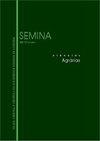Fermentation dynamics and quality of maize silage with Pigeon pea
IF 0.5
4区 农林科学
Q4 AGRICULTURE, MULTIDISCIPLINARY
引用次数: 1
Abstract
Tropical legumes are used to prepare mixed silages to enrich the crude protein (CP) content. In This context, objective of this study was to evaluate the dynamics of fermentation and quality of maize silage with different levels of Pigeon pea. The experimental design was entirely randomized, with four repetitions. The treatments comprised maize silages with six levels of added Pigeon pea (0, 20, 40, 60, 80, and 100%), calculated based on natural matter. The maize hybrid and Pigeon pea varieties used were B 2800 PWU and Cajanus cajan cv. BRS Mandarin, respectively. For the silage, the maize and Pigeon pea were harvested when they reached 335.7 g kg-1 dry matter (DM) and 281.3 g kg-1 DM, respectively. The results revealed that the added of up to 40% Pigeon pea in maize silages promote nutritive increment without compromising their fermentative profile of the silage. Exclusive Pigeon pea silage (100%) undergoes fermentative losses that compromise the silage quality. Therefore, mixed silages of maize with Pigeon pea, with appropriate levels of addition, are a viable alternative to increase the nutritive value of silages, mainly the CP content, contributing to reducing the cost of acquisition of protein salts.鸽豆青贮玉米发酵动力学及品质研究
热带豆类用于制备混合青贮饲料,以提高粗蛋白(CP)含量。在这种情况下,本研究的目的是评估不同水平的鸽子豌豆对玉米青贮饲料的发酵动力学和质量。实验设计完全随机,重复四次。处理包括玉米青贮饲料,其中添加了基于天然物质计算的六个水平的鸽子豌豆(0、20、40、60、80和100%)。使用的玉米杂交种和鸽子豌豆品种分别是B2800 PWU和Cajanus cajan cv.BRS Mandarin。对于青贮饲料,玉米和鸽子豌豆分别在干物质(DM)达到335.7 g kg-1和281.3 g kg-1时收获。结果表明,在玉米青贮饲料中添加高达40%的鸽子豌豆可以促进营养增加,而不会影响青贮饲料的发酵特性。独有的鸽子豌豆青贮饲料(100%)会发生发酵损失,影响青贮饲料的质量。因此,玉米和鸽子豌豆的混合青贮饲料,加上适当的添加量,是提高青贮饲料营养价值(主要是CP含量)的可行替代品,有助于降低蛋白质盐的获取成本。
本文章由计算机程序翻译,如有差异,请以英文原文为准。
求助全文
约1分钟内获得全文
求助全文
来源期刊

Semina-ciencias Agrarias
农林科学-农业综合
CiteScore
1.10
自引率
0.00%
发文量
148
审稿时长
3-6 weeks
期刊介绍:
The Journal Semina Ciencias Agrarias (Semina: Cien. Agrar.) is a quarterly publication promoting Science and Technology and is associated with the State University of Londrina. It publishes original and review articles, as well as case reports and communications in the field of Agricultural Sciences, Animal Sciences, Food Sciences and Veterinary Medicine.
 求助内容:
求助内容: 应助结果提醒方式:
应助结果提醒方式:


